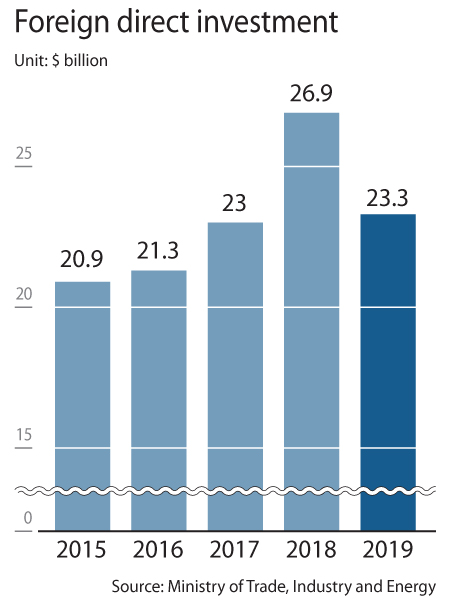FDI now firmly in the era of $20 billion a year

According to the Ministry of Trade, Industry and Energy Monday, FDI last year was $23.3 billion.
FDI dropped 13 percent from the all-time record of $26.9 billion set in 2018, but it has been running above $20 billion for five straight years.
“Last year’s FDI was slightly above the $23 billion averaged in the last five years,” said Jung Dae-jin, director-general of cross-border investment policy at the ministry. “As foreign investors have invested more than $20 billion in the last five years since 2015, we are now entering a phase of the $20 billion FDI period.”
FDI fell in 2019 due in part to external factors in the first half of the year, including shrinking global trade amid a trade war between U.S. and China.
The Korean government rollback of corporate tax cuts for foreign investment last year was also seen as a contributing factor.
In the first two quarters of 2019, FDI dropped more than 30 percent in each quarter.
It recovered 4.7 percent in the third quarter and jumped 27.9 percent year-on-year in the last three months of the year.
Aggressive promotions by leading companies and major mergers and acquisitions (M&A) transactions were the reason behind the increase in the fourth quarter.
FDI in the last quarter of the year was the highest ever recorded for a fourth quarter.
In the last three months of 2019, FDI totaled $9.84 billion, breaking the previous record set in 2018 of $9.36 billion.
By country, the biggest increase was in terms of U.S. investment, which grew 16.4 percent year-on-year to $6.84 billion.
U.S. investments centered on the services. U.S. investment in services grew 20.7 percent compared to the previous year to $4.88 billion. Its investment in manufacturing grew 9.7 percent to $1.95 billion.
By type, greenfield investments grew 36.3 percent to $6.72 billion. M&A declined 86.8 percent to $130 million.
European investment declined 20.1 percent to $7.13 billion. European investment in manufacturing fell 11.1 percent, while its service industry investment declined 9 percent to $3.73 billion.
While European greenfield investment fell 59.2 percent to $2.31 billion, M&A investments increased 48.1 percent to $4.82 billion.
Investment from China fell 64.2 percent to $980 million.
Its investment in services plummeted 76.2 percent to $190 million, while manufacturing FDI dropped 32.8 percent to $580 million.
Japanese investment grew 9.9 percent to $1.43 billion despite tensions with the country. While manufacturing investment fell 58.2 percent to $280 million, service FDI rose 80.4 percent to $1.14 billion. Greenfield investment was up 21.2 percent to $870 million, and M&A FDI surged 187.7 percent $560 million.
The government said it will continue to employ policies that would contribute to attracting more foreign investments, providing incentives for investments that contribute to the advancement of Korean industries.
This includes investment into materials, parts and equipment makers and also into new industries, such as future vehicles, the hydrogen economy, biopharmaceuticals and IT.
BY LEE HO-JEONG [lee.hojeong@joongang.co.kr]










with the Korea JoongAng Daily
To write comments, please log in to one of the accounts.
Standards Board Policy (0/250자)